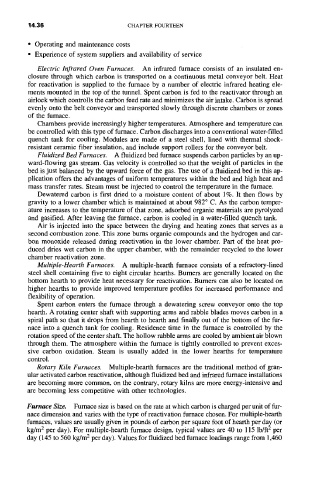Page 488 -
P. 488
14.36 CHAPTER FOURTEEN
• Operating and maintenance costs
• Experience of system suppliers and availability of service
Electric Infrared Oven Furnaces. An infrared furnace consists of an insulated en-
closure through which carbon is transported on a continuous metal conveyor belt. Heat
for reactivation is supplied to the furnace by a number of electric infrared heating ele-
ments mounted in the top of the tunnel. Spent carbon is fed to the reactivator through an
airlock which controlls the carbon feed rate and minimizes the air intake. Carbon is spread
evenly onto the belt conveyor and transported slowly through discrete chambers or zones
of the furnace.
Chambers provide increasingly higher temperatures. Atmosphere and temperature can
be controlled with this type of furnace. Carbon discharges into a conventional water-filled
quench tank for cooling. Modules are made of a steel shell, lined with thermal shock-
resistant ceramic fiber insulation, and include support rollers for the conveyor belt.
Fluidized Bed Furnaces. A fluidized bed furnace suspends carbon particles by an up-
ward-flowing gas stream. Gas velocity is controlled so that the weight of particles in the
bed is just balanced by the upward force of the gas. The use of a fluidized bed in this ap-
plication offers the advantages of uniform temperatures within the bed and high heat and
mass transfer rates. Steam must be injected to control the temperature in the furnace.
Dewatered carbon is first dried to a moisture content of about 1%. It then flows by
gravity to a lower chamber which is maintained at about 982 ° C. As the carbon temper-
ature increases to the temperature of that zone, adsorbed organic materials are pyrolyzed
and gasified. After leaving the furnace, carbon is cooled in a water-filled quench tank.
Air is injected into the space between the drying and heating zones that serves as a
second combustion zone. This zone burns organic compounds and the hydrogen and car-
bon monoxide released during reactivation in the lower chamber. Part of the heat pro-
duced dries wet carbon in the upper chamber, with the remainder recycled to the lower
chamber reactivation zone.
Multiple-Hearth Furnaces. A multiple-hearth furnace consists of a refractory-lined
steel shell containing five to eight circular hearths. Burners are generally located on the
bottom hearth to provide heat necessary for reactivation. Burners can also be located on
higher hearths to provide improved temperature profiles for increased performance and
flexibility of operation.
Spent carbon enters the furnace through a dewatering screw conveyor onto the top
hearth. A rotating center shaft with supporting arms and rabble blades moves carbon in a
spiral path so that it drops from hearth to hearth and finally out of the bottom of the fur-
nace into a quench tank for cooling. Residence time in the furnace is controlled by the
rotation speed of the center shaft. The hollow rabble arms are cooled by ambient air blown
through them. The atmosphere within the furnace is tightly controlled to prevent exces-
sive carbon oxidation. Steam is usually added in the lower hearths for temperature
control.
Rotary Kiln Furnaces. Multiple-hearth furnaces are the traditional method of gran-
ular activated carbon reactivation, although fluidized bed and infrared furnace installations
are becoming more common, on the contrary, rotary kilns are more energy-intensive and
are becoming less competitive with other technologies.
Furnace Size. Furnace size is based on the rate at which carbon is charged per unit of fur-
nace dimension and varies with the type of reactivation fumace chosen. For multiple-hearth
furnaces, values are usually given in pounds of carbon per square foot of hearth per day (or
kg/m 2 per day). For multiple-hearth furnace design, typical values are 40 to 115 lb/ft 2 per
day (145 to 560 kg/m 2 per day). Values for fluidized bed furnace loadings range from 1,460

